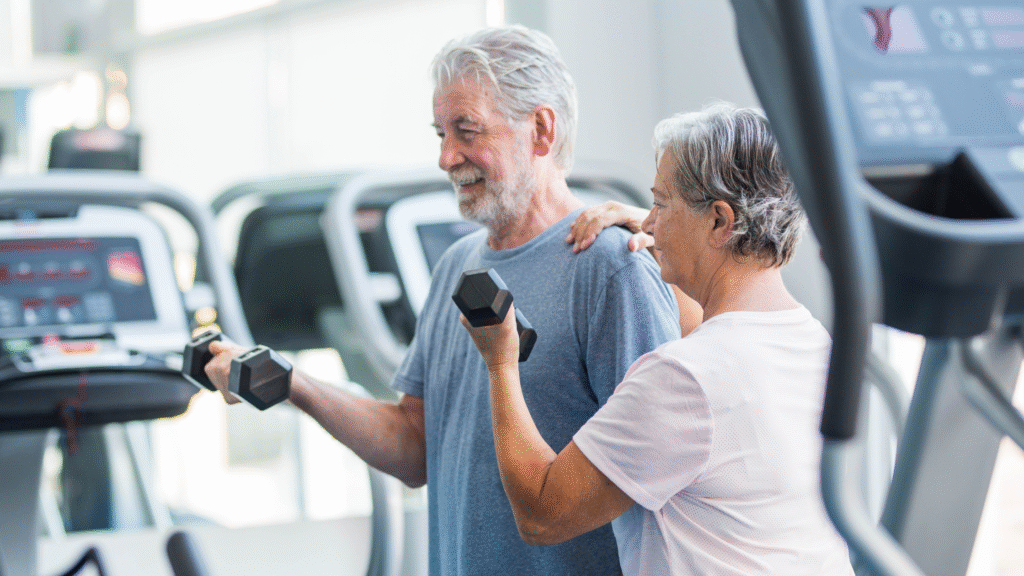Strength training isn’t just about bulging biceps — it’s a powerful tool to help you live longer and healthier. Recent research shows that regular weightlifting can lower your risk of dying at an older age. For example, a large Harvard study found that older adults who lifted weights regularly had a 9–22% lower risk of death, and those who did both weight training and cardio enjoyed a 41–47% lower mortality risk compared to inactive peers. In short, adding strength exercises to your routine can help you beat the odds of aging.
As the Mayo Clinic explains, strength training packs many health benefits: it builds strong bones, boosts metabolism to manage weight, and protects your joints from injury. Lifting weights also improves balance and daily function, reducing fall risk as we age, and can even help manage chronic conditions like arthritis or diabetes. In other words, pumping iron isn’t just for bodybuilders – it’s one of the smartest longevity habits you can adopt.
How Strength Training Boosts Longevity
Scientists are learning why weightlifting helps us live longer. When you stress muscles and bones with resistance, the body adapts in ways that fight aging. Strength training helps replace muscle mass that naturally declines with age (the “use it or lose it” effect). More muscle means a higher resting metabolism and better blood sugar control. At the same time, the stress on bones increases bone density, lowering osteoporosis risk.
Moreover, lifting weights seems to reduce inflammation and improve heart health. A recent review found that a regular lifting program combined with aerobic exercise dramatically cut mortality in seniors. One reason may be that combining strength and cardio covers all bases: cardio boosts heart and lung health, while strength training preserves muscle, bones, and metabolic health. Bottom line: mix in weights if you want to maximize your healthspan.
Top Benefits of Strength Training (All Ages)
Stronger Bones & Muscles: Weightlifting builds bone density and muscle mass, counteracting age-related decline.
Joint Protection: Strong muscles act as shock absorbers and stabilize joints, reducing arthritis pain and injury risk.
Better Metabolism: More muscle mass revs up your metabolism, helping you burn calories faster and control weight.
Improved Balance & Mobility: Muscle and core strength improve balance, making daily tasks and aging in place easier.
Reduced Chronic Disease Risk: Regular resistance training can lower blood pressure, improve insulin sensitivity, and even support mental health.
Sharper Brain Function: Emerging studies suggest lifting weights can improve memory and cognitive function in older adults.
Whether you’re 18 or 80, the science is clear: some strength work will make life better and longer.
Getting Started with Strength Training
You don’t need a fancy gym to begin. Here’s a simple starter plan:
Frequency: Aim for 2–3 strength sessions per week, targeting all major muscle groups (legs, back, chest, core, arms). Rest a day between sessions for recovery.
Exercises: Begin with bodyweight moves (squats, lunges, push-ups, planks) or light dumbbells. Focus on form and full range of motion. Even soup cans can work until you build strength!
Sets & Reps: Do 1–3 sets of 8–15 reps per exercise, using a weight that feels challenging by the last few reps. If you can easily do 15 reps, increase the weight slightly.
Progress Gradually: Increase weight or reps slowly as you get stronger. Over time, consider investing in adjustable dumbbells (for home use) to continue challenging your muscles. For example, the Kore Adjustable Dumbbells Set is a versatile option for a home gym.
Form & Safety: Warm up with 5–10 minutes of light cardio to get blood flowing. Use proper technique – consider a trainer or instructional video if you’re new. Listen to your body: stop any exercise that causes sharp pain.
Add Strength to Your Lifestyle
Even small amounts of weightlifting pay off. You don’t need to spend hours in the gym – just a focused 20–30 minute strength session a couple of times per week can yield benefits. Start with compound moves (squats, rows, push-ups) that work multiple muscles at once. Remember, consistency is key. Over months and years, those gains in muscle and bone density will compound into better longevity and quality of life.
Ready to feel stronger and live longer? Begin with light weights or bodyweight exercises today. In a few weeks, you’ll notice you can do more reps and feel more energetic. As you progress, add heavier weights or more challenging moves. With time, strength training will become a habit – and a powerful antidote to the physical decline of aging.












